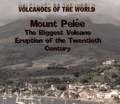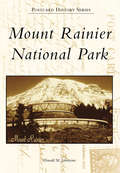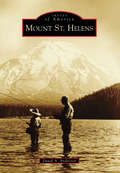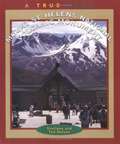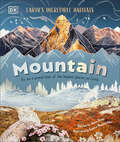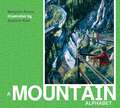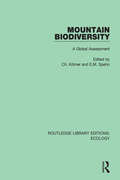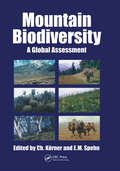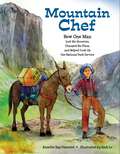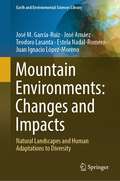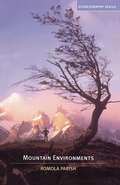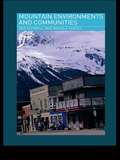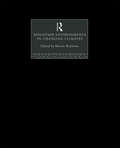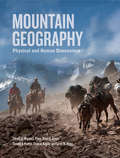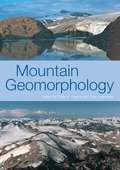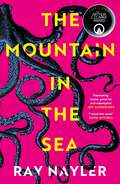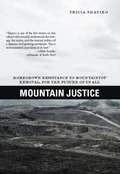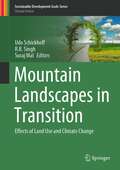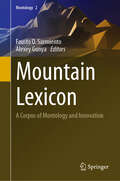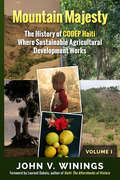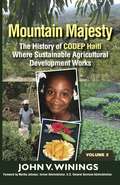- Table View
- List View
Mount Pelee: The Biggest Volcano Eruption of the 20th Century
by Kathy FurgangThis 1902 eruption occurred on the Caribbean island of Martinique. Only two of the 30,000 residents of the town of St. Pierre survived this blast. It was the first eruption that gave scientists a chance to observe the damage shortly after the event.
Mount Rainier National Park (Postcard History)
by Donald M. JohnstoneMount Rainier rises 14,410 feet above sea level and can be seen on any given day by over three million people and from over 100 miles away. It is America's fifth national park, established in 1899. The mountain is an active but currently dormant volcano. With 25 named glaciers, 50 smaller unnamed glaciers, and numerous perennial snowfields, Mount Rainier boasts the largest glacier system in the continental United States. In addition to the glacier zone, the park has alpine and subalpine forest and subtropical rain forest. Each zone has its own unique ecology of plants and animals. The vistas of and from the mountain are some of the most spectacular in all of the park system.
Mount St. Helens
by David A. AndersonThe story of Mount St. Helens is that of an active volcano and human interaction with it. The mountain is culturally important to the regional native people. Its Cowlitz name, Lawetlat'la, means "Person From Whom Smoke Comes." Early European settlers saw opportunities to make a living from the natural resources, and people fell in love with the forested valleys and slopes of the glacier-clad peak with the blue lake at its foot. Forgotten were the eruptions of the 19th century and the fact that the landscape was a product of frequent violent explosions. A report from the 1970s reminded locals that Mount St. Helens is an active volcano and could erupt again before the end of the 20th century. Only a few people at that time were aware of what the mountain was capable of, and many were surprised at the events that took place in 1980.
Mount St. Helens National Volcanic Monument (True Books-National Parks)
by Sharlene Nelson Ted NelsonNIMAC-sourced textbook <P><P>Describes the destruction caused by the eruption of Mount St. Helens in 1980. <P><P>Lexile Measure: 820L
Mountain: Go On a Grand Tour of the Highest Places on Earth (Earth's Incredible Habitats)
by DKThis stunning book all about mountains takes children on a grand tour of the highest places on Earth.From the salt flats of the Andes to the snow-capped peak of Mount Fuji, discover 14 of the world’s most spectacular mountains and mountain ranges, and the animals and plants that live in them. The chapters cover four different types of mountains: plateaus, volcanoes, mountain ranges, and tepuis, with a selection of both famous and less-well known places within each. Every mountain or range is explored in detail, with intriguing information about its geography and flora and fauna, alongside detailed photography and beautiful illustrations. Marvel at the Great Aletsch Glacier flowing down the Alps, mountain goats scrambling across cliff faces in the Rockies, and the tiny saltwort flowers that bloom 20,000 feet up in the Himalayas. As well as the wonders of these remote areas, the threats facing mountains and their species are also investigated.Habitat: Mountains will be treasured for years to come. With foil on the cover and colorful sprayed edges, this book makes the perfect gift for any child with a passion for the natural world.
A Mountain Alphabet (ABC Our Country)
by Margriet RuursMountains are an impressive sight anywhere in the world but those of the western mountain region of North America offer riches that are truly unique. This lavishly illustrated picture book presents snowcapped peaks, emerald lakes, tall pines and magnificent maples, and a range of birds and animals that will fill readers of all ages with wonder.The treasures and mysteries of nature are depicted in twenty-six full-color paintings, each with a line of alliterative text. Objects that begin with that letter of the alphabet are waiting to be discovered in each illustration. Complete with detailed information about each setting painted, this is a visually and mentally stimulating experience – from A to Z.
Mountain Biodiversity: A Global Assessment (Routledge Library Editions: Ecology #7)
by Ch. Körner E. M. SpehnOriginally published in 2002, Mountain Biodiversity deals with the biological richness, function and change of mountain environments. The book was birthed from the first global conference on mountain biodiversity and was a contribution to the International Year of Mountains in 2002. The book examines biological diversity as essential for the integrity of mountain ecosystems and argues that this dependency is likely to increase as environmental climates and social conditions change. This book seeks to examine the biological riches of all major mountain ranges, from around the world and using existing knowledge on mountain biodiversity, examines a broad range of research in diversity, including that of plants, animals, human and bacterial diversity. The book also examines climate change and mountain biodiversity as well as land use and conservation.
Mountain Biodiversity: A Global Assessment
by Ch. Körner E. M. SpehnThis book is the result of the first global conference on mountain biodiversity, and is a contribution to the International Year of Mountains, 2002. The Global Mountain Biodiversity Assessment program is a Special Target Area Region project of DIVERSITAS (UNESCO and UNEP). Biological diversity is essential for the integrity of mountain ecosystems and this dependency is likely to increase as environmental (climate) and social conditions change. Steep terrain and climate, and severe land-use pressure cause mountain ecosystems to rank among the world's most endangered landscapes. The 28 chapters in this book represent research on the biological riches in all major mountain ranges of the world, and synthesize existing knowledge on mountain biodiversity - from diversity of bacteria, plants and animals to human diversity. The book is divided into five sections: an introduction providing an overview of the issues; plant and animal diversity; climate change and mountain biodiversity; land use and conservation; and a synthesis.
Mountain Chef: How One Man Lost His Groceries, Changed His Plans, and Helped Cook Up the National Park Service
by Annette Bay PimentelThe true story of a Chinese American mountain man who fed thirty people for ten days in the wilderness--and helped inspire the creation of the National Park Service. Tie Sing was born in the mountains. The mountains were in his blood. But because he was of Chinese descent at a time in America when to be Chinese meant working in restaurants or laundries, Tie Sing&’s prospects were limited. But he had bigger plans. He began cooking for mapmakers and soon built a reputation as the best trail cook in California. When millionaire Stephen Mather began his quest to create a national park service in 1915, he invited a group of influential men—writers, tycoons, members of Congress, and even a movie star—to go camping in the Sierras. Tie Sing was hired to cook. Tie Sing planned diligently. He understood the importance of this trip. But when disaster struck—twice!—and Tie Sing&’s supplies were lost, it was his creative spirit and quick mind that saved the day. His sumptuous menus had to be struck and Tie Sing had to start over in order to feed the thirty people in the group for ten whole days. His skills were tested and Tie Sing rose to the challenge. On the last night, he fed not just the campers' bodies, but also their minds, reminding them to remember and protect the mountains. 2016 marks the 100th anniversary of the National Park Service, created by Congress on August 25, 1916. Today, you can hike to Sing Peak, named for Tie Sing, in Yosemite National Park.
Mountain Environments: Natural Landscapes and Human Adaptations to Diversity (Earth and Environmental Sciences Library)
by José M. García-Ruiz José Arnáez Teodoro Lasanta Estela Nadal-Romero Juan Ignacio López- MorenoThis book studies mountains with a global perspective, like a complex topographic and topoclimatic mosaic organized in altitudinal belts that are influenced by a huge variability in slopes, soils, lithology and insolation. Furthermore, the presence of lower temperatures, higher precipitation and the seasonal presence of snow create conditions conductive to supporting various life forms and natural geomorphological and hydrological processes. The integration of environmental and human aspects highlights the impacts of human activities and climate fluctuations on soil hydrology, soil erosion, water resources, and landscape/landforms evolution. After presenting the way in which humans (from Prehistory to Alexander von Humboldt) discovered the mountains, subsequent chapters try to underline the importance of mountains in generating water resources and hydropower for lowlands, serving as biodiversity hotspots, and contributing to cultural diversity. The book delves into the role ofhuman actives in transforming the natural landscapes and creating new cultural landscapes. This exploration considers the significance of altitudinal belts in shaping the spatial and temporal organization of land uses which, in turn, have been determined by population growth and the development of regional and national markets. Additionally, the book illustrates the effect of global change on mountain evolution, exploring their consequences on landscape characteristics and dynamics as well as on the planetary role of the mountains. It concludes by offering a unique perspective on enhancing mountain conservation in order to preserve cultures, land uses, and landscapes.
Mountain Environments (Ecogeography Series)
by Romola ParishThis book breaks the ground in Geographical texts by transcending a strictly regional or topical focus. It presents the opportunities and constraints that mountains and their resources offer to local and global populations; the impacts of environmental and economic change, development and globalisation on mountain environments. Part of the Ecogeography series edited by Richard Hugget
Mountain Environments and Communities (Routledge Physical Environment Ser.)
by Don Funnell Romola ParishMountain Environments and Communities explains the background physical environment and then explores the environmental and social dimensions of mountain regions.This critical review of the concepts currently employed in mountain research, draws upon a wide range of examples from developed and developing countries. The dynamics of mountain life are described through both historical accounts of village-based systems and examples of the contemporary impact of global capital and sustainable development strategies.
Mountain Environments in Changing Climates
by Martin BenistonHome to large numbers of people, sources of water, centres of tourism, and sensitive ecological zones, mountain environments share distinctive climactic characteristics. Once regarded as economically non-viable regions, mountains now attract major investment as sites of tourism, hydro-power and communication routes. This book brings together some of the current work on the physical and human ecology of mountain environments, the impacts of climate change, the processes involved and their observation and prediction.
Mountain Geography
by Alton Byers Martin Price Larry W. Price Donald Friend Thomas KohlerMountains cover a quarter of the Earth's land surface and a quarter of the global population lives in or adjacent to these areas. The global importance of mountains is recognized particularly because they provide critical resources, such as water, food and wood; contain high levels of biological and cultural diversity; and are often places for tourism and recreation and/or of sacred significance. This major revision of Larry Price's book Mountains and Man (1981) is both timely and highly appropriate. The past three decades have been a period of remarkable progress in our understanding of mountains from an academic point of view. Of even greater importance is that society at large now realizes that mountains and the people who reside in them are not isolated from the mainstream of world affairs, but are vital if we are to achieve an environmentally sustainable future. Mountain Geography is a comprehensive resource that gives readers an in-depth understanding of the geographical processes occurring in the world's mountains and the overall impact of these regions on culture and society as a whole. The volume begins with an introduction to how mountains are defined, followed by a comprehensive treatment of their physical geography: origins, climatology, snow and ice, landforms and geomorphic processes, soils, vegetation, and wildlife. The concluding chapters provide an introduction to the human geography of mountains: attitudes toward mountains, people living in mountain regions and their livelihoods and interactions within dynamic environments, the diverse types of mountain agriculture, and the challenges of sustainable mountain development.
Mountain Geography
by Larry W. Price Thomas Kohler Alton C. Byers Martin F. Price Donald A. FriendMountains cover a quarter of the Earth's land surface and a quarter of the global population lives in or adjacent to these areas. The global importance of mountains is recognized particularly because they provide critical resources, such as water, food and wood; contain high levels of biological and cultural diversity; and are often places for tourism and recreation and/or of sacred significance. This major revision of Larry Price's book Mountains and Man (1981) is both timely and highly appropriate. The past three decades have been a period of remarkable progress in our understanding of mountains from an academic point of view. Of even greater importance is that society at large now realizes that mountains and the people who reside in them are not isolated from the mainstream of world affairs, but are vital if we are to achieve an environmentally sustainable future. Mountain Geography is a comprehensive resource that gives readers an in-depth understanding of the geographical processes occurring in the world's mountains and the overall impact of these regions on culture and society as a whole. The volume begins with an introduction to how mountains are defined, followed by a comprehensive treatment of their physical geography: origins, climatology, snow and ice, landforms and geomorphic processes, soils, vegetation, and wildlife. The concluding chapters provide an introduction to the human geography of mountains: attitudes toward mountains, people living in mountain regions and their livelihoods and interactions within dynamic environments, the diverse types of mountain agriculture, and the challenges of sustainable mountain development.
MOUNTAIN GEOMORPHOLOGY
by Phil Owens Olav SlaymakerMountains represent one of the most inspiring and attractive natural features on the surface of the earth. Visually, they dominate the landscape. However, the increasing realization of the fragility of mountain areas because of changes in land use, management and climate, combined with an understanding of their importance for water and other natural resources, has resulted in a growing interest in mountain environments in recent years. Hence, Mountain Geomorphology represents a timely and unique contribution to the literature. Written by a team of international experts, this book is divided into three sections, which consider historical, functional and applied mountain geomorphology from both global and local perspectives. Historical mountain geomorphology focuses on the evolution of landforms. Functional mountain geomorphology emphasises the interaction between processes and landforms, while applied mountain geomorphology concerns the interrelationships between geomorphological processes and society. Mountain Geomorphology is a valuable source of information for students studying mountain geomorphology, and also for academics and research scientists interested in mountain environments.
The Mountain in the Sea
by Ray Nayler'I loved this novel's brain and heart'DAVID MITCHELL, AUTHOR OF CLOUD ATLAS'A first-rate speculative thriller, by turns fascinating, brutal, powerful, and redemptive'JEFF VANDERMEER, AUTHOR OF ANNIHILATIONThere are creatures in the water of Con Dao. To the locals, they're monsters. To the corporate owners of the island, an opportunity. To the team of three sent to study them, a revelation. Their minds are unlike ours. Their bodies are malleable, transformable, shifting. They can communicate. And they want us to leave.When pioneering marine biologist Dr. Ha Nguyen is offered the chance to travel to the remote Con Dao Archipelago to investigate a highly intelligent, dangerous octopus species, she doesn't pause long enough to look at the fine print. DIANIMA- a transnational tech corporation best known for its groundbreaking work in artificial intelligence - has purchased the islands, evacuated their population and sealed the archipelago off from the world so that Nguyen can focus on her research.But the stakes are high: the octopuses hold the key to unprecedented breakthroughs in extrahuman intelligence and there are vast fortunes to be made by whoever can take advantage of their advancements. And no one has yet asked the octopuses what they think. And what they might do about it.
Mountain Justice
by Tricia Shapiro"Shapiro is one of the few writers on this subject that actually understands the strategy, the tactics, and the internal politics of a dynamic and growing movement. This is environmental journalism at it best."-Mike Roselle, Earth First! founder and author of Tree SpikerMountaintop removal (MTR) does exactly what it says: a mountaintop is stripped of trees, blown to bits with explosives, then pushed aside by giant equipment-all to expose a layer of coal to be mined. Hundreds of thousands of acres of ancient forested mountains have been "removed" this way and will never again support the biologically rich and diverse forest and stream communities that evolved there over millions of years-all to support our flawed national energy policy.Mountain Justice tells a terrific set of firsthand stories about living with MTR and offers on-the-scene-and behind-the-scenes-reporting of what people are doing to try to stop it. Tricia Shapiro lets the victims of mountaintop removal and their allies tell their own stories, allowing moments of quiet dignity and righteous indignation to share center stage. Includes coverage of the sharp escalation of anti-MTR civil disobedience, with more than 130 arrests in West Virginia alone during the first year of the Obama administration.Tricia Shapiro has been closely following and writing about efforts to end large-scale strip mining for coal in Appalachia since 2004. She now lives on a remote mountain homestead in western North Carolina, near the Tennessee border.
Mountain Landscapes in Transition: Effects of Land Use and Climate Change (Sustainable Development Goals Series)
by R. B. Singh Udo Schickhoff Suraj MalThis book compiles available knowledge of the response of mountain ecosystems to recent climate and land use change and intends to bridge the gap between science, policy and the community concerned. The chapters present key concepts, major drivers and key processes of mountain response, providing transdisciplinary orientation to mountain studies incorporating experiences of academics, community leaders and policy-makers from developed and less developed countries. The book chapters are arranged in two sections. The first section concerns the response processes of mountain environments to climate change. This section addresses climate change itself (past, current and future changes of temperature and precipitation) and its impacts on the cryosphere, hydrosphere, biosphere, and human-environment systems. The second section focuses on the response processes of mountain environments to land use/land cover change. The case studies address effects of changing agriculture and pastoralism, forest/water resources management and urbanization processes, landscape management, and biodiversity conservation. The book is designed as an interdisciplinary publication which critically evaluates developments in mountains of the world with contributions from both social and natural sciences.
Mountain Lexicon: A Corpus of Montology and Innovation (Montology #2)
by Fausto O. Sarmiento Alexey GunyaThis book is the second volume in a series on montology dedicated to the transdisciplinary reflection of mountain research, considering the diversity of views on mountains and their problemata in the context of rapid technological development and unprecedented accumulation and dissemination of information around the world. The necessity for a new orderly and structured lexicon arose from the need to critically reassess the colonial past in the development of mountain territories, the development of a new and alternative understanding of mountain topics in the light of decolonized epistemology. The creation of coordinated and ordered terms for the main parts of mountain research creates the basis for an unorthodox understanding of the ontology of mountains and helps to better understand the complex cultural and natural essence of mountain socio-ecological systems. At the same time, a local episteme of mountains, considering local values, small scales, and vernacular visions are of particular importance, which must be taken into account in the current terminology. The purpose of the book is to provide methodological support for montology as a convergent and transdisciplinary science of mountains, based on the harmonization of its terminological base. The book pays special attention to onomastics, toponymy, standardization and other nuances of terms used in mountain research. According to this goal, three dozen articles in a relatively small format (about 3 pages) vividly, attractively and innovatively reflect the modern view of one or more related terms. Articles include definition(s) of the term, description of etymology, onomastics or toponymy used, examples of local characteristics compared to traditional sources, possible vernacular terms. Articles are grouped into four main areas: 1) Basic glossary of montology terminology, 2) Towards mountain socio-ecological systems, 3) Innovative disciplinary systemic realm, 4) Mountain classifications, onomastics, critical toponomy and rediscovery of meaning. The authors of the articles are leading experts in the field of mountain research from around the world. The book is intended for scientists, experts and teachers. It is provided with an annotated list of the most important montology terms.
Mountain Majesty: The History of CODEP Haiti Where Sustainable Agricultural Development Works (Vol 1)
by John V WiningsMountain Majesty: The History of CODEP Haiti Where Sustainable Agricultural Development Works takes an in-depth look at a unique organization that has improved the lives of thousands of rural Haitians through sustainable agricultural development. Together, Jack and Evelyn Hanna embarked on their dream retirement. They outfitted a boat to cruise the Caribbean islands and planned to do volunteer work where they could. But a chance encounter with a desperate Barbadian woman challenged their assumptions and ultimately changed the course of countless lives.
Mountain Majesty: A History Of Codep Haiti Where Sustainable Agricultural Development Works Vol. 2
by John V WiningsWhat makes...an organization successful? A leader effective? A community thrive? Especially in impoverished, disaster-prone Haiti? Mountain Majesty: The History of CODEP Haiti Where Sustainable Agricultural Development Works, Volume 2 reveals the inner workings and complexities of this remarkable organization as it grew into today’s highly successful, locally-managed Haitian NGO. Professionals and academics will find a vital case study in organizational leadership. Casual readers will enjoy cultural insights and personal stories that illustrate how CODEP caused hope to grow on trees in rural Haiti.
Mountain Majesty: The History of CODEP Haiti Where Sustainable Agricultural Development Works (Vol 3)
by John V. WiningsIs it possible to change the world, or at least some part of it?Mountain Majesty: The History of CODEP Haiti Where Sustainable Agricultural Development Works takes an in-depth look at a unique organization that has improved the lives of thousands of rural Haitians through sustainable agricultural development.Together, Jack and Evelyn Hanna embarked on their dream retirement. They outfitted a boat to cruise the Caribbean islands and planned to do volunteer work where they could. But a chance encounter with a desperate Barbadian woman challenged their assumptions and ultimately changed the course of countless lives from another island in the region.Rural Haitian kids often go hungry. They wear tattered clothing and have no shoes. Many people suffer from malnutrition and severe poverty. Hurricanes, floods, deforestation and soil erosion, coupled with political instability, high unemployment and a lack of infrastructure conspire to prevent them from being able to grow enough food to feed their families. In Haiti's Cormier Valley, Jack saw the terrain - huge patches of completely barren land no trees, huge gullies, no soil incapable of sustaining life, plant or animal - and recognized that the only way to help the people of the Cormier Valley was to address the whole watershed area through sustainable agriculture.CODEP was brought to life by the Presbyterian Church (U.S.A.), working with local Haitians and NGOs. They embarked on an ambitious reforestation and erosion control project to ultimately improve the economic conditions for rural Haitians in the Cormier Valley.Sustainable agricultural development is challenging work, but locals saw first-hand just what it could do for their community. They dug ditches and bolstered mountainsides. They germinated, grew and planted trees. They overcame interference from goats, insects and embargos. They upgraded infrastructure and slowly secured additional land for planting. CODEP has encouraged responsible ecological stewardship and reaping the benefits of long-term rewards. Their project solutions are more attractive than the common practice of cutting down trees for charcoal and some quick cash. As a result, CODEP is one of the more successful agricultural development projects in Haiti, and possibly in the world. Nowadays, beautiful fruit trees grow in the forest shade and the people of Cormier Valley are healthier than ever before.Mountain Majesty: The History of CODEP Haiti Where Sustainable Agricultural Development Works documents this fascinating change from environmental degradation to habitat redemption, where environmental rehabilitation led to the restoration of human dignity.A deeply personal story, Mountain Majesty profiles leaders and participants like the Haitians Edvy and Nwèl and project architects Jack and Rodney, exploring their lives, motivations and actions. It also addresses the management issues that non-profits and church mission projects often face.How can we really help the people we want to help?How do we secure more funding?How do we ensure stakeholder participation?How can we identify and develop local leaders?How do we adequately set goals and measure progress?How can we keep donors happy?How do we balance competing interests?How do we keep moving forward when the founder leaves?How do we ensure sustainability?These are some of the questions that keep nonprofits awake at night, and some of the lessons offered by this book.
Mountain Movers: Mining, Sustainability and the Agents of Change (Routledge Studies of the Extractive Industries and Sustainable Development)
by Daniel M. FranksThe products of mining are everywhere – if it wasn’t grown, it was mined or drilled. But the mining industry has a chequered past. Pollution, human rights abuses, and corruption have tarnished the reputation of the industry across the globe. Over a decade ago the major mining companies embraced the concept of sustainable and equitable development and embarked on an explicit process of reform – but has the industry actually changed? This book explores the dynamics of change-making for sustainable development in the resources sector, specifically the mining of mineral and energy resources. The author recounts the stories and insights of over forty change-makers both inside and outside the industry, from anti-mining activists to the professionals charged with the task of reform, introducing the people who are moving an industry that moves mountains. The book takes stock of what has worked and what has not, analyzing the relative influence and dynamics of the key corporate, civil society and government actors with a view to developing new approaches for improving environmental and social outcomes from mineral and energy development. Illustrated with case studies from Angola, Australia, Brazil, Canada, Chile, Colombia, El Salvador, Guinea, Peru, The Philippines, Romania, Sierra Leone, South Africa, and The United States of America, and brimming with the backstories to the major sustainability initiatives, Mountain Movers reveals where progress has been made and where reform is still needed towards a more sustainable and equitable mining industry.
Mountain Nature
by Jennifer Frick-RuppertThe Southern Appalachians are home to a breathtakingly diverse array of living things--from delicate orchids to carnivorous pitcher plants, from migrating butterflies to flying squirrels, and from brawny black bears to more species of salamander than anywhere else in the world. Mountain Nature is a lively and engaging account of the ecology of this remarkable region. It explores the animals and plants of the Southern Appalachians and the webs of interdependence that connect them.Within the region's roughly 35 million acres, extending from north Georgia through the Carolinas to northern Virginia, exists a mosaic of habitats, each fostering its own unique natural community. Stories of the animals and plants of the Southern Appalachians are intertwined with descriptions of the seasons, giving readers a glimpse into the interlinked rhythms of nature, from daily and yearly cycles to long-term geological changes. Residents and visitors to Great Smoky Mountains or Shenandoah National Parks, the Blue Ridge Parkway, or any of the national forests or other natural attractions within the region will welcome this appealing introduction to its ecological wonders.
